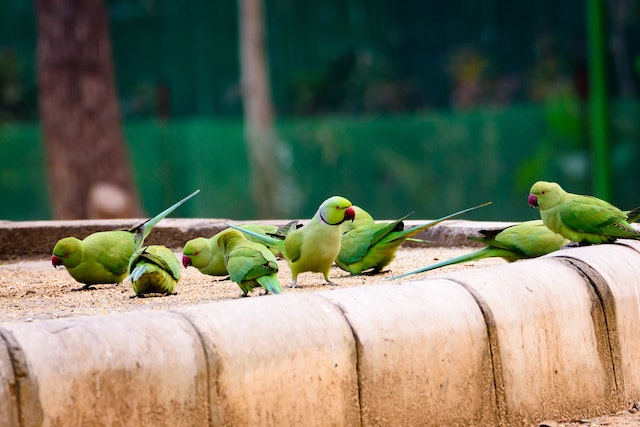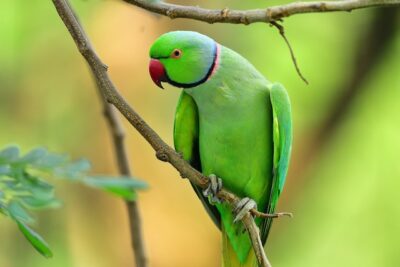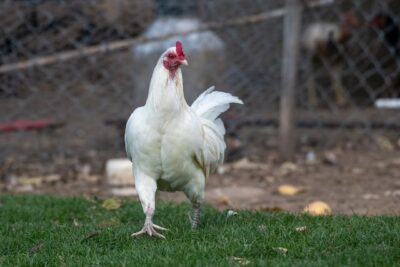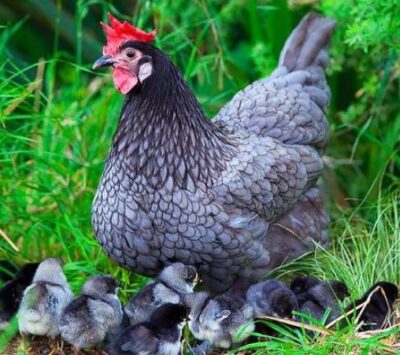Birds, with their captivating beauty and charming personalities, have a unique appeal as pets. They bring vibrancy and joy to any home, making them wonderful companions. If you’re new to the world of avian companionship, it’s important to choose a pet bird species that matches your experience level and lifestyle.
In this article, we’ll delve into the 10 best types of pet birds for beginners, exploring their characteristics, care requirements, and reasons why they make excellent choices for novice bird enthusiasts.
10 Best Types Of Pet Birds For Beginners:
1. Budgerigar: The Friendly Parakeet
Budgerigars, commonly known as budgies, are a popular choice for beginners due to their friendly and sociable nature. With their striking colors and playful demeanor, budgies quickly form strong bonds with their human caregivers.
These small parrots are known for their ability to mimic sounds and even words, adding an entertaining element to your household. Budgies are relatively low-maintenance and thrive in smaller living spaces, making them an ideal choice for apartment dwellers.
2. Finch: Tiny Birds with Cheerful Chirps
Finches are another fantastic option for beginners, known for their cheerful chirps and active behavior. These tiny birds come in various species and colors, each with their own unique charm.
Zebra finches and society finches are particularly well-suited for beginners, as they are easy to care for and adapt well to new environments. Finches are relatively low-maintenance birds that require minimal handling, making them a great choice for those who prefer to observe their avian companions from afar.
3. Canaries: Beautiful Singing Companions
Canaries are beloved for their melodic songs and vibrant plumage. These charming birds are not only visually appealing but also bring delightful tunes to your home. Canaries are relatively low-maintenance, requiring a proper cage, nutritious diet, and a peaceful environment.
They don’t need as much interaction as some other bird species, making them suitable for individuals who have limited time for hands-on interaction but still want the joy of having a pet bird.
4. Cockatiel: Charismatic Cockatoos
Cockatiels are charismatic and affectionate birds that have captured the hearts of pet owners worldwide. These medium-sized parrots are known for their playful behavior and their ability to bond closely with their human companions. Cockatiels are highly trainable and can learn to perform tricks, making them a joy to interact with. Their crest feathers, which they raise and lower depending on their mood, add to their endearing personality.
5. Lovebirds: Playful and Affectionate
Lovebirds are named for their strong pair bonds and affectionate behavior. These small parrots are known for their lively personalities and their tendency to form deep connections with their human caregivers. Lovebirds thrive on interaction and enjoy spending time with their owners.
However, it’s important to note that lovebirds are social birds and may become stressed if kept alone for extended periods. Providing companionship or spending ample time with your lovebird is crucial for their well-being.
6. Parrotlet: Small Parrots with Big Personalities
Parrotlets may be small in size, but they have big personalities. These intelligent birds are known for their active nature and their ability to learn tricks and commands. Parrotlets bond closely with their owners and enjoy mental stimulation through toys, puzzles, and social interaction. Their vibrant colors and curious behaviors make them captivating companions, suitable for individuals who are willing to dedicate time to their care and interaction.
7. Pionus: Gentle and Intelligent
Pionus parrots are gentle birds known for their calm and friendly demeanor. They are quieter than some other parrot species, making them suitable for apartment living. Pionus parrots are intelligent birds that enjoy mental stimulation, such as puzzle toys and foraging activities. They form strong bonds with their caregivers and thrive in environments where they receive attention and companionship.
8. Bourke’s Parakeet: Quiet and Colorful
Bourke’s parakeets are known for their peaceful nature and stunning pastel colors. These relatively quiet birds are content with a calm environment and can thrive in smaller living spaces. Bourke’s parakeets are not as demanding as some other species, making them well-suited for beginners who want low-maintenance pet birds. Providing them with a spacious cage, appropriate diet, and occasional social interaction will ensure their well-being.
9. Quaker Parrot: Social and Vocal
Quaker parrots, also known as monk parakeets, are highly social and interactive birds. They are known for their vibrant personalities and their ability to mimic sounds and speech. Quaker parrots require regular social interaction and mental stimulation to thrive. While their vocalizations can be entertaining, potential owners should be prepared for their lively chatter. Quaker parrots form strong bonds with their human companions and thrive in households that can provide ample engagement.
10. Conure: Energetic and Lively
Conures are energetic birds known for their playful behavior and vibrant colors. These medium-sized parrots have an active lifestyle and enjoy playing with toys, climbing, and exploring their environment. Conures form strong bonds with their owners and are happiest when they receive ample social interaction and mental stimulation. Their lively antics and charming personalities make them a joy to have as companions.
Embracing the Joy of Avian Companionship
Welcoming pet birds into your home can be an enriching experience filled with joy, laughter, and shared moments. The 10 bird species highlighted in this article offer a diverse range of personalities, behaviors, and appearances. From the charismatic cockatiels to the playful lovebirds, there’s a bird for every individual’s preferences and lifestyles.
Remember that while birds are delightful companions, they also require dedicated care and attention. Interacting with your bird, providing mental stimulation through toys and games, and creating a safe and comfortable environment are all crucial aspects of responsible pet ownership. Whether you’re looking for a feathered friend to brighten up your living space or seeking a new and exciting bond, these 10 best types of pet birds for beginners have something special to offer.
Conclusion:
Choosing the right pet birds as a beginner can be a rewarding experience. Each of the 10 pet bird species discussed in this article offers unique qualities that can match different preferences and lifestyles. Whether you’re drawn to the melodic songs of canaries or the playful antics of conures, there’s a feathered friend waiting to bring joy, companionship, and vibrant energy into your home.
FAQs:
1. Can I keep pet birds in the same cage?
It’s generally recommended to pet birds of the same species together to ensure compatibility and minimise stress. Mixing different species may lead to conflicts.
2. How can I ensure my pet bird’s happiness?
Providing a spacious cage, a balanced diet, mental stimulation through toys and interaction, and a peaceful environment are key to ensuring your pet bird’s happiness.
3. Do these pet birds require special veterinary care?
Like all pets, regular veterinary check-ups are important. Avian veterinarians have specialised knowledge to provide the best care for your pet bird’s health.
4. Are pet birds suitable for families with children?
Many of these birds can be great additions to families with children, but supervision and proper training are essential to ensure the safety of both the birds and the children.
5. How can I teach my bird to talk or perform tricks?
Training requires patience and consistency. Using positive reinforcement, such as treats and praise, can help motivate your bird to learn new behaviours and tricks.
6. Can I teach my bird to do more than mimic sounds?
Absolutely! Birds like cockatiels, conures, and parrotlets are highly intelligent and can learn a variety of tricks and behaviours through positive reinforcement training.
7. What type of cage is best for pet birds?
Choose a cage appropriate for the bird’s size, with horizontal bars for climbing. Make sure it’s spacious enough for them to spread their wings and move comfortably.
8. Do pet birds need social interaction beyond their owners?
While some birds are content with human companionship, others benefit from interaction with fellow birds. Research the social needs of the specific species you’re interested in.
9. How can I prevent my bird from getting bored?
Provide a variety of toys, puzzles, and activities to keep your bird mentally stimulated. Rotate toys regularly to keep things fresh and engaging.
10. What should I do if my bird shows signs of illness?
If you notice any changes in behaviour, appetite, or appearance, consult an avian veterinarian promptly. Birds often hide signs of illness, so early detection is crucial.










